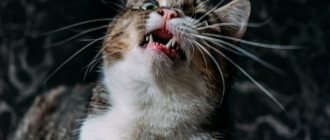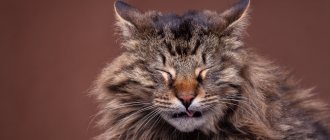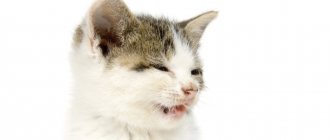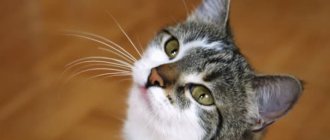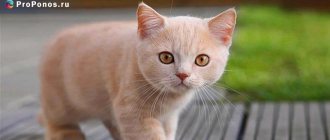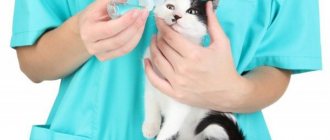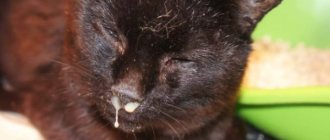Why does a cat sneeze?
Sneezing in cats can be caused by unfavorable factors of various natures. For example, the sneeze reflex in animals is a reaction to the influence of any allergen that irritates the mucous membrane of the upper respiratory tract. The ingress of dust particles, pollen from flowering plants, and household chemicals irritate the receptors in the nasal mucosa, which is accompanied by sneezing.
The cat sneezes
Important! As a rule, sneezing in cats and other animals is caused by irritation of the nerve endings located on the mucous membrane of the respiratory tract.
Often, sneezing can be a symptom of a respiratory illness. A common runny nose, as a rule, is always accompanied by a reflexive sneezing reflex. Thus, the animal’s body clears the respiratory tract from accumulated exudate.
recommended articles:
- Pneumonia in cats
- Antiviral drugs for cats
Cats, cats, kittens sneeze when:
- asthma;
- colds;
- viral, bacterial, fungal infections;
- the presence of polyps in the nose;
- neoplasms in the respiratory tract, upper respiratory tract;
- severe hypothermia;
- congenital pathologies, anatomical defects in the structure of the respiratory organs;
- chronic respiratory diseases (tonsillitis, rhinotracheitis, sinusitis);
- the presence of foreign objects in the larynx.
The sneezing reflex in cats can be triggered by sharp, pungent odors, for example, perfume, eau de toilette, air freshener, tobacco smoke. Molds that live on wall surfaces, congenital pathologies, and anatomical defects of the respiratory tract organs provoke sneezing attacks in cats.
Once in the upper respiratory tract, allergens of various nature irritate the mucous membranes and lead to frequent sneezing. Sneezing and sniffling in cats are often signs of seasonal allergies.
By what signs can you diagnose the disease yourself?
If the reason for a cat’s sneezing lies in the presence of a foreign object in the nasopharynx, then it can be identified by the cat’s behavior - most likely, he will try with all his might to get rid of the speck that is bothering him.
This is usually expressed in the fact that the cat snorts intensely, sneezes, rubs its nose with its paw, can spin, shake its head and express concern in every possible way.
In this case, examining the cat’s nose and mouth can help clarify the situation – it is quite possible that you will be able to see an object that has gotten into your pet’s nose and thus be able to give him an accurate diagnosis: he is sneezing because of a speck.
Things are more complicated with self-diagnosis of infectious and viral diseases. Even a qualified veterinarian may not be able to distinguish them from each other with a simple examination; special tests will be required. However, you can assume that your pet is sneezing due to an infection by looking at the pattern and color of the snot coming out of his nose. If the snot is green and, as it dries, turns into crusts, then most likely your cat has caught some kind of infection. There are additional symptoms characteristic of such conditions:
- general lethargy and increased drowsiness of the animal;
- increased body temperature;
- refusal to eat.
If, after examining the snot, you find that it has a rather liquid consistency and a transparent color, then there is a high probability that allergic reactions provoke sneezing attacks in the cat. As a rule, in this case the cat’s eyes still water.
© shutterstock
If your cat is sneezing and suffering from snot due to an eye infection, this can usually be recognized by the following signs:
- the animal’s eyes become very watery, sometimes swollen and red;
- pus accumulates in the corners of the eyes;
- The cat cannot open his eyelids completely.
Look into your pet's mouth - if you find that there is an unpleasant odor coming from there, the gums are inflamed or there are pustules on them, then it is quite possible that the cause of snot when sneezing is a purulent process occurring in the mouth.
If you notice that when you sneeze, blood is released along with snot from the nose or mouth, this may indicate the presence of an injury to the respiratory tract or a serious cancer.
Causes of snot
If sneezing is accompanied by a runny nose, mucous, and purulent discharge from the eyes, the symptoms do not go away within 7-10 days; rather, the reason for this condition lies in the development of infectious processes in the body of the pet. Sneezing, coughing, or rhinitis may indicate that your beloved cat is sick with parasitic, viral, or bacterial diseases.
One of the first manifestations of peritonitis, plague, calcivirosis, viral pneumonia, helminthic infestations, and other parasitic diseases is a runny nose, frequent sneezing, coughing, and serous-catarrhal discharge from the eyes.
The cat is sneezing, there is noticeable discharge from the eyes
A runny nose in cats, kittens, cats can occur against the background of allergic reactions, when foreign bodies or objects enter the respiratory tract. Nasal discharge can be: serous, catarrhal, purulent. In cases of chronic rhinitis, blood clotting disorders, and feline viral immunodeficiency, bloody threads, clots, and inclusions are noticeable in the discharge from the nose.
Reasons why a cat's nose can't breathe
Nasal congestion is an obstruction of the nasal passages that occurs for two main reasons:
- with excessive discharge, especially purulent discharge, which thickens and dries, filling the nasal passages;
- with swelling of the mucous membrane due to a severe inflammatory process, most often caused by viruses or bacteria.
The main reason why a cat has a stuffy nose and sneezes is acute infectious diseases. Unlike humans, cats almost never suffer from allergic swelling of the mucous membranes.
What to do?
If your cat’s eyes are very watery, the general condition has worsened, and your pet begins to sneeze frequently, you should consult a veterinarian. The animal may have contracted an eye infection. In this case, it is necessary to treat the eyes with ophthalmic solutions, which can be purchased at a veterinary pharmacy, or rinse the eyes with decoctions of medicinal plants, for example, a warm infusion of chamomile flowers.
If your cat sneezes, snorts, or rubs his nose with his paw, there is most likely a foreign object in the nose. You can alleviate your pet's condition by using special tweezers or any other available means. All manipulations should be carried out extremely carefully so as not to hurt the cat or injure the mucous membrane.
The cat rubs its face with its paw
Having noticed mucous discharge from the nose, shortness of breath, difficulty breathing, swollen red eyes in a cat or kitten, it is necessary to establish the cause of this condition. Most likely, sneezing is caused by allergens. It is worth consulting with a veterinarian who will select a safe, most effective antihistamine.
Important! If blood or blood clots are released when sneezing, this may indicate the development of cancer or serious damage to the nasal passages.
Increased body temperature, enlarged submandibular lymph nodes, lethargy, decreased activity, refusal of food and treats, profuse nasal discharge are a serious cause for concern. Therefore, contact your veterinarian and take the cat to a veterinary hospital.
Fluffy patients with viral infections will be prescribed complex treatment, antibiotic therapy (Fosprenil, Maxidin), anti-inflammatory, antipyretic drugs. To normalize the general condition of furry purrs, vitamin complexes, mineral supplements, and immunomodulators will be prescribed.
Drops for the treatment of rhinitis
In case of a runny nose, the cat’s nasal passages are washed with hypotonic solutions, and the mucous membrane is irrigated with 0.5% tannin, galazolin, and thymogen.
If the sneezing reflex and snot are provoked by helminthic infestation, the cats will be prescribed effective helminthic drugs. For fungal infections - fungicidal, antifungal medications.
The veterinarian will prescribe effective treatment therapy
Sneezing caused by allergies is treated with antiallergic medications, special medicinal creams, and ointments. It is equally important to eliminate allergens from the cat’s external environment.
During treatment, owners must strictly follow all recommendations of the attending physician and provide the pet with the most comfortable living conditions. In case of respiratory diseases, it is absolutely unacceptable for the cat to be in a draft! Constantly remove discharge from the eyes and nose with sterile cotton-gauze swabs soaked in antiseptic solutions.
Preventive measures
In order not to be tormented by the question of how to treat if a cat is sneezing and has snot, it is necessary to carry out preventive measures. You should monitor your pet’s immune system, increase its protective properties, then the pet will be able to resist various diseases, including viral and infectious ones.
Prevention is as follows:
- It is strictly forbidden to walk a cat without appropriate vaccinations, which can be done at any veterinary clinic;
- do not allow small kittens to remain outside for long periods of time, especially in cold and rainy weather;
- When ventilating the room, drafts should not be allowed, especially if it is a damp time of year outside, it is better to remove the cat from this room;
- It is necessary to carry out wet cleaning daily, in which case you can rid the apartment of many microbes that the owners bring from the street on outerwear and shoes;
- if your pet’s diet does not contain high-quality premium food, then you should definitely feed the cat with special vitamins, which can be purchased at any pet store;
- clean water and fresh milk should always be available, and both liquids should be at room temperature, since drinking too cold can cause a cold in your pet;
- if you have an allergic reaction to any chemical or household product, you should stop using them, as these allergens can cause a chronic runny nose;
- animals living in an apartment must be dewormed on a regular basis; it is recommended to do this at least once every 6 months, so that random parasites that enter the body do not cause an infectious disease;
- Every 10 days you should rinse your pet’s nasal passages, this must be done with warm water.
The main thing is that a pet kitten should not only be looked after and fed, but the pet must be loved. Only in this case will he be active, healthy and happy. And if trouble does occur and your pet has a runny nose, you must immediately seek help from a veterinary clinic, where correct and effective treatment will be prescribed.
Prevention of respiratory diseases
Owners of furry pets must provide proper care for their pets. Nei should place the cat house in drafts, near heating appliances. You need to systematically examine the eyes, mouth, and nose of your favorite cat, especially if the animal walks freely on the street.
It is equally important to monitor the cleanliness of the air in the house, apartment, and indoor air humidity. To strengthen the immune system, if the cat is kept on a natural diet, to increase resistance, cats need to be given multivitamin preparations and mineral supplements.
We invite you to join our Zen channel and group on VKontakte or Odnoklassniki, where new articles for pet owners are published.
Similar articles:
- My cat has a nosebleed - what should I do?
- Inflammation of the lower lip in a cat
- Clear nasal discharge in cats
How to help a cat if he is sneezing with snot?
From all of the above, we can draw a logical conclusion that the thickness and stagnation of mucus lead to an increase in the inflammatory process. No matter what the animal’s initial illness is, when it has a runny nose, our task is to help the cat restore normal breathing and reduce inflammation in the nose.
For this, rinsing the nose and instilling various drops that kill bacteria and stimulate the immune system are very suitable. The technique of washing and using drops is described in detail in the article “What to do at home if your cat sneezes?”
If the cat is snotty and sneezing, the procedure will help remove accumulations of pus, soothe the mucous membranes and help restore breathing.
Of course, local treatment will be meaningless without treating the main cause of the runny nose, so you must definitely visit a veterinarian - often the appearance of “ordinary” snot is a manifestation of serious illnesses.
Prevention
To avoid having to deal with the issue of sneezing and snot in your cat, it is better to play it safe and think about taking preventive measures in order to increase the cat’s body’s resistance to diseases and protect your pet from possible complications.
- Firstly, it is important to prevent the cat from becoming hypothermic: in cold weather, take short walks, and do not sit in drafts in the house.
- Secondly, do wet cleaning in the house more often to prevent dust from appearing, and remove all small things that may end up in the cat’s nose.
- Thirdly, the cat’s diet must be balanced, containing nutrients and vitamins.
- Fourthly, the drink should be no colder than room temperature, so as not to provoke a cold.
- Fifthly, limit the cat’s access to flowering plants and detergents, and also do not spray perfume near him.
- Sixth, install a mosquito net on the windows to avoid insect bites on your pet and thereby protect it from the terrible consequences discussed above.
- Seventh, visit the veterinarian regularly and get all the necessary vaccinations.
This is what cat runny nose is like, if it is not treated in time, it will turn into a chronic form, or into an even more terrible and dangerous complication - pneumonia. But there is no need to be scared, but it is better not to waste time and get timely treatment.
Causes of the disease
The disease can occur for a number of reasons, including:
- Improper maintenance of a mustachioed pet. A cat can become hypothermic while outside or on a balcony; catch a cold due to drafts moving around the room; “earn” a runny nose if the hair remains wet after washing.
- Viral infection. Pets can become ill by contracting the disease from sick street animals.
Incorrectly selected food, lack of proper care, and the presence of chronic illnesses weaken the body’s immune system; weakened immunity contributes to the development of colds.
If the owner is confident that the animal is being kept properly and there are symptoms of the disease, then it is necessary to treat the animal for a viral infection.
Veterinarians call the disease “rinotracheitis”, it refers to complex diseases, the causative agent is a virus located in the external environment, found in the urine, feces, and secretions of a sick individual. Can be transmitted through direct contact by airborne droplets.
A cat that doesn't go outside can still become infected. The pathogen can enter the apartment by ending up on the owner’s street shoes or clothes.

